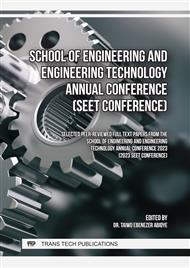p.33
p.41
p.49
p.59
p.67
p.73
p.85
p.99
p.111
Enhancement of Concrete Properties Using Sawdust Ash and Superplasticizer
Abstract:
Concrete is a construction material that is widely embraced worldwide with a major disadvantage of environmental unfriendliness arising from the production process of cement, one of its vital components. Recent studies have found that replacing cement with pozzolans increases compressive strength, durability, and occasionally workability, although at a low replacement percentage. The low replacement level obtained can be improved upon with the use of superplasticizer to further enhance the workability and the compressive strength. Therefore, the primary objective of this study is to determine the effects of adding Costamix 200 superplasticizer and partially replacing cement with sawdust ash (SDA) for cement on the mechanical properties of the resultant concrete. Waste sawdust was collected, dried, and then burnt in a furnace for 60 minutes at 700°C. Concrete samples were made using 150 x 150 x 150 mm3 rectangular and 100mm cylindrical molds using a 1:2:4 mix ratio, 0.55 water cement ratio, a constant dosage of 1.8% superplasticizer (Costamix 200), and SDA at 0%, 5%, 10%, 15%, 20%, and 30% SDA respectively. The concrete samples were tested at 7, 14, 21, and 28 days for bulk density, split tensile strength, and compressive strength were carried out. The outcomes of the research show that the presence of costamix 200 and SDA at 0%, 5%, 10%, 15%, and 20% cement substitution resulted in compressive strength range of 18.91 N/mm2 to 25.00 N/mm2 at 28 days. The optimum value of 25.00 N/mm2 was recorded for 15% replacement making it ideal for use in structural applications such as beams, slab and column.
Info:
Periodical:
Pages:
67-72
Citation:
Online since:
July 2024
Price:
Сopyright:
© 2024 Trans Tech Publications Ltd. All Rights Reserved
Share:
Citation:


